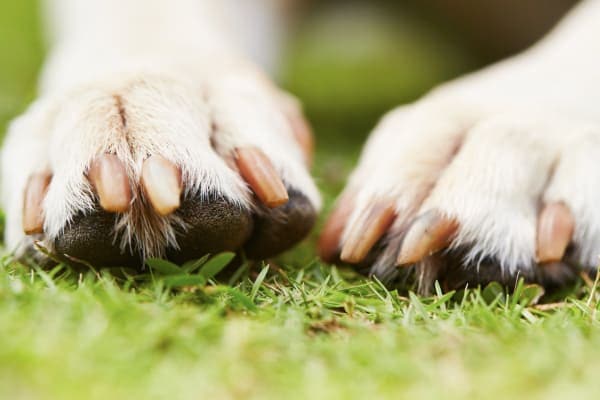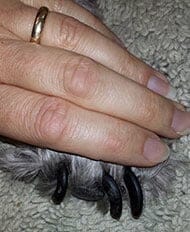
Why dog nail care is key to your dog’s good health
In their natural environment, dogs run, climb, and dig. This keeps their nails worn down. In contrast, most domestic dogs live on hard-surface floors and rarely get sufficient exercise. The byproducts of this lifestyle include obesity, behavioral problems, and long toenails.
The most ubiquitous problem I saw when I owned a general veterinary practice, and now see in my holistic practice, is one in the same—long toenails.”
Long nails are not just a cosmetic issue
When a dog has long toenails, it can actually change the way his or her paws interface with the ground and negatively affect both posture and gait. Here’s why:
- Dogs’ toes have an abundance of proprioceptive receptors. These receptors provide information to the central nervous system about the body’s position in relation to the ground. When a dog’s nails are excessively long, the brain receives faulty data and makes adjustments accordingly. The result is a dog who has poor posture and an altered gait.
- A dog with long toenails can’t stand with legs perpendicular to the ground. Rather, he compensates–his forelegs are “behind” perpendicular and the hind legs must come under him to prevent him from tipping forward. This chronic compensatory posture takes a toll on the body and predisposes to injury.
- When a dog walks with long toenails it can be likened to humans walking in oversized clown shoes. When presented with a new patient, after taking the history, I generally begin with a simple (and pain-free) toenail trim. This instantly changes the dog’s posture and gait, so when I do my gaiting and chiropractic exams, I can focus on deeper, root issues, not secondary problems from long toenails. My five-minute short-nail makeover yields some degree of instant improvement for most of my new patients.
Some of my clients prefer that I continue to trim their dog’s nails after our initial visit. Others are willing to learn to do it themselves, which makes me proud. I trim my own dog’s nails every one to two weeks and recommend a maximum interval of four weeks for my patients.
'Routine nail trims are commonly overlooked as part of our canine companions' preventative health care. However, they hold significant potential to improve our dogs' quality of life.'Click To TweetAs the founder of ToeGrips® dog nail grips for dogs, I’m especially passionate about pairing the application of ToeGrips® dog nail grips with proper dog nail care. Regular, quality nail trims for dogs are critical! Toenails that are too long affect:
Proprioception—A dog’s toes contain an abundance of receptors which help his brain understand where his body is in relation to the ground. When a dog’s nails become too long, this distorts the toes, affecting the brain’s input signals.

Pain—Long toenails create chronic bad posture. Bad posture is uncomfortable for the dog and predisposes to degeneration and injury, as chronic abnormal forces are placed into the dog’s joints, tendons, and/or ligaments. Additionally, the animal is stressed and the adrenal glands increase cortisol production. Excess cortisol takes a toll on many body systems, but is known to cause ligament laxity (weakening). This predisposes to injury.
Safety—Long, hard toenails cannot grip slick flooring, making the dog more likely to slip, and less confident on hard, smooth surfaces. In nature, dogs use their toenails to get traction on terrain (similar to soccer cleats). When they flex their digits (with long nails) to attempt to gain traction on hard-surface flooring, it simply makes the slipping worse.
Gait—Watch a dog with long nails gait before and immediately after a quality nail trim. That dog will instantly have an improved breakover and stride, which will translate into a more efficient and comfortable gait.
How to get the quicks to recede
The key to getting a dog’s quicks to recede is the frequency of the nail trimming or dremeling. It’s a myth that if you trim the nails every few weeks the quicks will recede. The reason the quicks recede is that there is some form of stimulus (vibratory and otherwise) affecting the quick (the nerve + blood supply to the tip of the nail), which the nerve seeks to reduce exposure to by receding.
So the way to have success is to cut or dremel the nails back to the “pre-quick” so that the quick is stimulated TO recede. And this must be done very frequently, i.e. every two to three days. It takes this type of commitment to get the quicks to recede, but it can be done.

